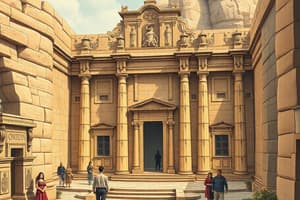Podcast
Questions and Answers
What material was the Sutton Hoo Purse Cover made from?
What material was the Sutton Hoo Purse Cover made from?
- Gold, Enamel, and Garnet (correct)
- Leather
- Silver
- Bronze
Who produced the Lindisfarne Cross Page?
Who produced the Lindisfarne Cross Page?
Bishop Eadfrith
The Book of Kells was created in _____ AD.
The Book of Kells was created in _____ AD.
800
The animal head from the Oseberg Ship Burial is thought to be for Queen Asa.
The animal head from the Oseberg Ship Burial is thought to be for Queen Asa.
What distinctive style is evident in the reliefs on the front cover of the Lindau Gospels?
What distinctive style is evident in the reliefs on the front cover of the Lindau Gospels?
What significant structure did Charlemagne build at Aachen?
What significant structure did Charlemagne build at Aachen?
Match the following artworks with their characteristics:
Match the following artworks with their characteristics:
What technique was used to create the doors of Bishop Bernward?
What technique was used to create the doors of Bishop Bernward?
Flashcards are hidden until you start studying
Study Notes
Sutton Hoo Purse Cover
- Created during the Early Medieval period, notable for its intricate design including gold, enamel, and garnet.
- Features three hinges for leather straps, reminiscent of a sporran worn by Scots.
- Displays motifs that suggest a blend of various influences and origins, particularly Mesopotamian art dating back over 3200 years.
- Noted for its interlacing bands and animal style, indicative of cultural migrations.
Lindisfarne Cross Page
- Produced in 700 AD using tempera on vellum in Northumbria, England.
- Crafted by Bishop Eadfrith with aesthetic depth likened to that of a jeweler.
- The complex geometric frame showcases animal interlace, viewed as a sacred riddle requiring decryption.
Book of Kells, Chi Rho Iota Page
- An elaborately crafted manuscript created around 800 AD, representing the peak of Hiberno-Saxon manuscript art.
- Features "XPI," the Greek initials for Christ, alongside swirling designs, similar to Lindisfarne's cross page.
- First manuscript to incorporate human figures and elements of the natural world, introducing animals like cats and otters.
Animal Head, Early Medieval
- Wood artifact from the Oseberg Ship Burial, dating to 834 AD, showcasing Viking artistry.
- Its use remains uncertain but may have been linked to processions or cult activities, evincing detailed craftsmanship.
- Covers animal head in intricate interlacing and geometric patterns, believed to belong to Queen Asa.
St. Matthew from the Gospel Book of Charlemagne
- Created in 800 AD, employing ink and colors on vellum, showcasing mastery of Roman painting techniques.
- Features realistic modeling and shading, rendering a sense of depth and drapery in the figures.
St. Matthew from the Gospel Book of Archbishop Ebbo of Reims
- Produced three decades post the Gospel of Charlemagne, reflecting a vibrant artistic energy.
- The composition suggests dynamic movement, with environmental elements appearing to swirl in the wind.
- Known for expressive flickering lines, presenting a model of divine inspiration.
Lindau Gospels Cover
- Created in 870 AD, reflecting the "Reims" style with raised reliefs on the cover adorned with semi-precious stones.
- Christ depicted in a serene manner, indicating a triumphant resurrection rather than suffering.
- Symbolizes Carolingian dedication to preserving literature and art.
Palace Chapel of Charlemagne
- Built in Aachen, Germany (792-805) by architect Odo of Metz as a symbol of Charlemagne's Christian authority.
- Modeled after Constantine's palace in Rome, it included a basilica as part of its structure.
Doors of Bishop Bernward
- Commissioned in 1015 during the Ottonian period, cast in bronze utilizing the lost-wax process.
- Stands over 16 feet tall, representing significant monumental sculpture since early Christian times.
- Each door narrates biblical stories, showcasing an innovative approach to door decoration.
Studying That Suits You
Use AI to generate personalized quizzes and flashcards to suit your learning preferences.




